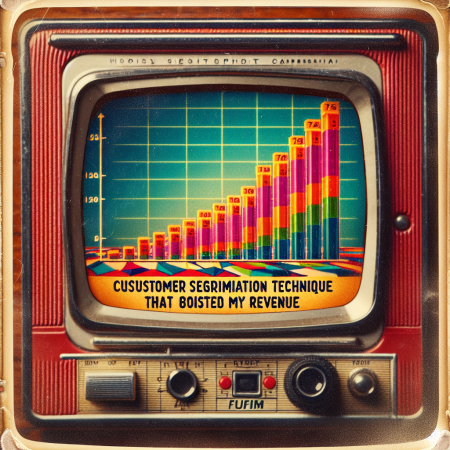The Customer Segmentation Technique That Boosted My Revenue
Identifying the Right Segments
Understanding Your Customer Base
When I first dived into customer segmentation, I realized that knowing who my customers really were made all the difference. It’s not just about collecting data; it’s about understanding what drives your customers. Their interests, behaviors, and demographics often reveal patterns that can help customize your offerings.
I spent time analyzing previous purchase data and customer feedback. This helped me identify different clusters within my audience, each with unique cravings and expectations. You see folks, it’s about asking the right questions. What do they value? How do they shop? Tailoring messages based on this insight made my marketing efforts way more effective.
Trust me when I say this: you can’t assume all your customers think alike. They belong to different worlds! By properly identifying these segments, I created targeted campaigns that resonated with each group. It’s just like having a conversation with someone who gets you, instead of shouting into the void.
Crafting Personalized Campaigns
Using Segmentation Data Effectively
Once I had clear segments identified, it was time to roll up my sleeves and get personal. I started crafting marketing messages tailored to each segment. You wouldn’t believe how much more engaged my audience became! For example, instead of sending a generic email blast, I crafted specific messages that spoke to each segment’s interests.
This personalized approach didn’t just improve my open rates; it genuinely connected with my customers. It felt good knowing that I was speaking directly to their needs and not just bombarding them with random promotions. Customers appreciate when they feel understood, and this approach became my secret sauce for syncing with customer expectations.
The beauty of personalized campaigns is in their flexibility. I was able to adjust my strategies based on what was working and what wasn’t, ultimately refining my approach even further. It’s a win-win situation: customers feel seen, and I see increased engagement, even sales!
Utilizing Behavioral Data
Understanding Customer Journeys
I can’t stress enough the significance of behavioral data. This is the goldmine that tells you not just who your customers are, but how they interact with your products or services. By analyzing how customers navigate my website, their purchase history, and even their social media engagement, I was able to map out their journey.
Understanding the customer journey helps you pinpoint pain points and opportunities for improvement. For instance, if I noticed a drop-off at a certain stage in the purchase process, I knew I had to investigate. It was all about fixing those roadblocks and keeping those sales rolling in.
As a result, I’ve been able to design marketing strategies that align perfectly with where my customers are in their journey. Knowing when to nudge them with a reminder or when to upsell has made a massive impact on my revenue stream.
Continuous Testing and Optimization
Experimenting with Different Approaches
When diving into customer segmentation, I quickly learnt that it’s crucial to keep testing different strategies. It’s not a one-time gig! I regularly run A/B tests to see what resonates more with my audience. Remember, what worked yesterday might not work today.
By experimenting with different messaging, offers, and channels, I found out a lot about my segments. Testing has allowed me to take calculated risks and tweak my campaigns for the better. It’s all about learning what truly captures my audience’s attention and adapting accordingly.
Optimization isn’t just a fancy marketing term; it’s a mindset. If something’s not working, don’t obsess over it. Pivot! Use those insights to improve, and don’t be afraid to freshen up your approach. It’s all part of the game!
Measuring Success
Defining Key Performance Indicators (KPIs)
The final piece to the puzzle is measuring success. Establishing clear KPIs was a game changer for me! I figured out which metrics I was going to track – from conversion rates to customer retention rates, knowing what to measure kept my eyes on the prize.
With these KPIs in hand, I was able to assess the impact of my segmentation efforts and campaigns better. Each metric provided insights into areas for improvement, and this feedback loop was crucial for refining my strategies over time.
In this digital world, data is your best friend. It tells a story that can guide you in shaping your marketing strategies. Plus, celebrating wins big or small was a motivational boost that kept the momentum going!
Frequently Asked Questions
What is customer segmentation?
Customer segmentation is the process of dividing your customers into distinct groups based on specific characteristics, preferences, or behaviors. This allows businesses to tailor marketing efforts to meet the unique needs of each group effectively.
How can I identify my customer segments?
You can identify customer segments by analyzing data like demographics, purchase history, and preferences. Customer surveys and feedback can also provide insights into their interests and behaviors.
Why is personalized marketing important?
Personalized marketing creates deeper connections with customers as it caters to their specific needs and preferences, resulting in higher engagement and conversion rates. Customers appreciate being recognized as individuals.
What should I do if my segmentation strategy isn’t working?
If your segmentation strategy isn’t showing results, it’s essential to revisit your data and insights. Analyzing customer behavior and feedback can highlight areas for improvement, and being open to tweaking your approach is vital!
How do I measure the success of my customer segmentation efforts?
Measuring success involves defining and tracking key performance indicators (KPIs), like conversion rates, customer retention rates, and engagement metrics. Regularly assessing your strategies against these KPIs will help gauge effectiveness.
Related Content
- Multiply traffic by creating shareable infographics aligned with 2025 design trends
- How To Create an Effective Crisis Management Plan for Your Online Presence
- How to Use Twitter for Online Marketing
- The Benefits of Social Media Marketing for Small Businesses
- Me after following every ‘grow your brand’ tip on the internet



